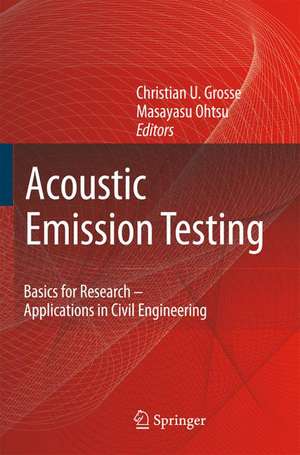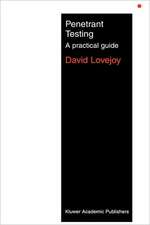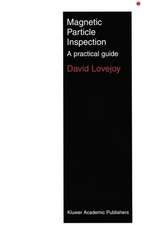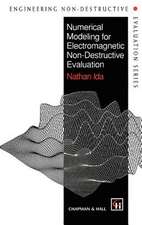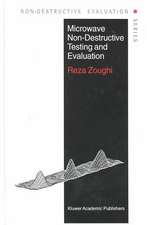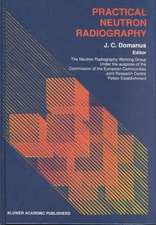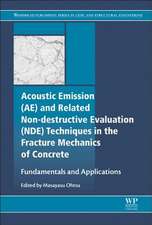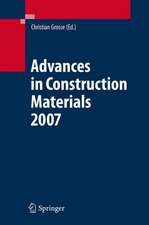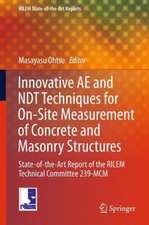Acoustic Emission Testing
Editat de Christian U. Grosse, Masayasu Ohtsuen Limba Engleză Hardback – 23 iul 2008
| Toate formatele și edițiile | Preț | Express |
|---|---|---|
| Paperback (1) | 980.23 lei 38-44 zile | |
| Springer Berlin, Heidelberg – 14 oct 2010 | 980.23 lei 38-44 zile | |
| Hardback (1) | 958.38 lei 6-8 săpt. | |
| Springer Berlin, Heidelberg – 23 iul 2008 | 958.38 lei 6-8 săpt. |
Preț: 958.38 lei
Preț vechi: 1168.76 lei
-18% Nou
Puncte Express: 1438
Preț estimativ în valută:
183.38€ • 191.98$ • 151.74£
183.38€ • 191.98$ • 151.74£
Carte tipărită la comandă
Livrare economică 05-19 aprilie
Preluare comenzi: 021 569.72.76
Specificații
ISBN-13: 9783540698951
ISBN-10: 3540698957
Pagini: 416
Ilustrații: X, 406 p. 270 illus.
Dimensiuni: 155 x 235 x 26 mm
Greutate: 0.82 kg
Ediția:2008
Editura: Springer Berlin, Heidelberg
Colecția Springer
Locul publicării:Berlin, Heidelberg, Germany
ISBN-10: 3540698957
Pagini: 416
Ilustrații: X, 406 p. 270 illus.
Dimensiuni: 155 x 235 x 26 mm
Greutate: 0.82 kg
Ediția:2008
Editura: Springer Berlin, Heidelberg
Colecția Springer
Locul publicării:Berlin, Heidelberg, Germany
Public țintă
ResearchCuprins
Basics.- History and Fundamentals.- Sensor and Instrument.- Parameter Analysis.- Signal-Based AE Analysis.- Source Localization.- Source Mechanisms of AE.- Moment Tensor Analysis.- Applications.- General Remarks on Applications.- Concrete.- Acoustic Emission in Study of Rock Stability.- Acoustic Emissions in Wood.- Superstructures.- Substructures.- Wireless Sensing and Acoustic Emission Array Techniques.- Opportunities, Limitations, Accuracy and Skill.
Notă biografică
Prof. Dr.-Ing. habil. Christian U. Grosse, born 1961, studied Geophysics at the University of Karlsruhe (TH) and earned his Ph.D. in 1996 in Civil Engineering at the University of Stuttgart followed by his Habilitation in 2005 at the same place. He is University lecturer at the University of Stuttgart and head of the Department of "Non-destructive testing and monitoring techniques" at the Material Testing Institute MPA, University of Stuttgart. In 2007 he became Associate Director of the MPA. His research interest include the application and development of non-destructive testing methods (ultrasound, acoustic emission, impact-echo, vibration analysis, Radar) as well as structural health monitoring using wireless sensor networks.
Dr. Masayasu Ohtsu is a professor at the Graduate School of Science and Technology, Kumamoto University, Japan. Currently, he is a chairman of Technical Committee TC212-ACD in RILEM and a regional editor of the journal Construction and Building Materials for Elsevier. He graduated from Kyoto University, Japan in 1974, and received his Dr. Eng. in 1982. He is also an associate member of Committee 228 on non-destructive testing of concrete in ACI and has been studying the applications of AE techniques to concrete engineering for more than 20 years.
Dr. Masayasu Ohtsu is a professor at the Graduate School of Science and Technology, Kumamoto University, Japan. Currently, he is a chairman of Technical Committee TC212-ACD in RILEM and a regional editor of the journal Construction and Building Materials for Elsevier. He graduated from Kyoto University, Japan in 1974, and received his Dr. Eng. in 1982. He is also an associate member of Committee 228 on non-destructive testing of concrete in ACI and has been studying the applications of AE techniques to concrete engineering for more than 20 years.
Textul de pe ultima copertă
Acoustic Emission (AE) techniques have been studied in civil engineering for a long time. The techniques are recently going to be more and more applied to practical applications and to be standardized in the codes. This is because the increase of aging structures and disastrous damages due to recent earthquakes urgently demand for maintenance and retrofit of civil structures in service for example. It results in the need for the development of advanced and effective inspection techniques. Thus, AE techniques draw a great attention to diagnostic applications and in material testing. The book covers all levels from the description of AE basics for AE beginners (level of a student) to sophisticated AE algorithms and applications to real large-scale structures as well as the observation of the cracking process in laboratory specimen to study fracture processes.
Caracteristici
First edited book on this topic which is very important within structural health monitoring Includes supplementary material: sn.pub/extras
Descriere
Descriere de la o altă ediție sau format:
Acoustic Emission (AE) techniques have been studied in civil engineering for a long time. The techniques are recently going to be more and more applied to practical applications and to be standardized in the codes. This is because the increase of aging structures and disastrous damages due to recent earthquakes urgently demand for maintenance and retrofit of civil structures in service for example. It results in the need for the development of advanced and effective inspection techniques. Thus, AE techniques draw a great attention to diagnostic applications and in material testing. The book covers all levels from the description of AE basics for AE beginners (level of a student) to sophisticated AE algorithms and applications to real large-scale structures as well as the observation of the cracking process in laboratory specimen to study fracture processes.
Acoustic Emission (AE) techniques have been studied in civil engineering for a long time. The techniques are recently going to be more and more applied to practical applications and to be standardized in the codes. This is because the increase of aging structures and disastrous damages due to recent earthquakes urgently demand for maintenance and retrofit of civil structures in service for example. It results in the need for the development of advanced and effective inspection techniques. Thus, AE techniques draw a great attention to diagnostic applications and in material testing. The book covers all levels from the description of AE basics for AE beginners (level of a student) to sophisticated AE algorithms and applications to real large-scale structures as well as the observation of the cracking process in laboratory specimen to study fracture processes.
